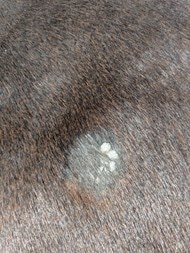Sarcoids
By: Dr. Lydia Gray

What is it?
Sarcoids are the most common skin tumor in horses. Most experts believe they are caused by the bovine papilloma virus (BPV) although there is a genetic component to tumor development. That is, Sarcoids tend to run in families. They occur in young to middle-aged horses (3-12 years) and can be found anywhere on the body, although most are located on the head, legs and belly. There are four types of sarcoids:
- Verrucous or wart-like tumors
- Fibroblastic or proud flesh-like tumors
- Mixed verrucous and fibroblastic tumors
- Occult or flat tumors (hair loss, scales and crusting)
What can be done about it?
A veterinarian should examine any skin growths, areas of hair loss or other changes to diagnose the cause and recommend appropriate treatment. Unfortunately, no single treatment is universally effective in eliminating Sarcoid tumors. Treatment options for active tumors include cryotherapy, surgical removal, BCG injections, radiofrequency hyperthermia, carbon dioxide laser surgery, radiation therapy, and cisplatin injections.
What else do I need to know?
Although Sarcoids do not spread throughout the body (metastasize), they can be very aggressive locally--especially if disturbed. Even confirming the diagnosis by skin biopsy runs the risk of triggering growth in a dormant Sarcoid into growth. For this reason, verrucous and occult tumors especially that are not active should be left alone.
see also: melanoma
SmartPak strongly encourages you to consult your veterinarian regarding specific questions about your horse's health. This information is not intended to diagnose or treat any disease, and is purely educational.